I am not going to the Angouleme Festival this year, 2017.
In 2014 I wrote a series of reports for The Comics Reporter that I never got around to ganging up and presenting here. So below are all those reports in one report:
***
REPORT 1
This year I offered to write some pieces for The Comics Reporter for fun (and to score myself a Press Pass!). I had imagined that my pieces would dance around the edges of Bart's usual play-by-play posts. I did not know until this morning that he would not be walking his usual beat this year, delivering genuine news stateside.
Bart's interest and knowledge of global comics and local Angouleme festival politics far exceeds my own. I suspect that my posts will be far more anecdotal and lacking in objectivity (as well as anything resembling real news).
To those of you who have come to depend on Bart Beaty's reporting, I join you in hoping that he returns to the Festival the near future.
In the meantime:
Here are a few things you should know if you are visiting the festival for the first time.
1. It's a comics festival.
This may come as a surprise to U.S. visitors who expect Comics Festivals to be about movies and television and computer games. The focus here is comics.
Wait, let me rephrase that, the real focus here is to separate attendees from the contents of their wallets -- through comics. Comics for every taste and demographic, many of which you will find nowhere else, are for sale everywhere.
2. Angouleme is a tangled mass of tiny streets.
You will get lost as soon as you land. The festival hands out oodles of free maps that you will see overflowing from trashcans throughout the city because they are essentially useless. Even Google Maps has given up on Angouleme, replacing the usual street map on your iPhone with a color drawing of Professor Calculus holding his divining pendulum and shrugging his shoulders.
3. Skip the schedule as well as the map.
Here's an example: last year I followed the schedule and went to the location where I thought I was going to see an inking demonstration by an interesting Chinese artist. Instead I found there a living-tableau recreation of Asterix and Obelix outfoxing some Romans. I snuck out and, while trying to get my bearings, found myself in an auditorium where Joost Swarte was singing the blues -- a performance which was nowhere to be found listed on any schedule.
4. To sum it up: go with the flow.
The best way to enjoy Angouleme is to exit the train from Paris waving a white flag on a stick. Wander, be surprised, and be prepared to empty the contents of your wallet on the byways of this crazy little town.
REPORT 2
Jacques Tardi and The Goddamn War
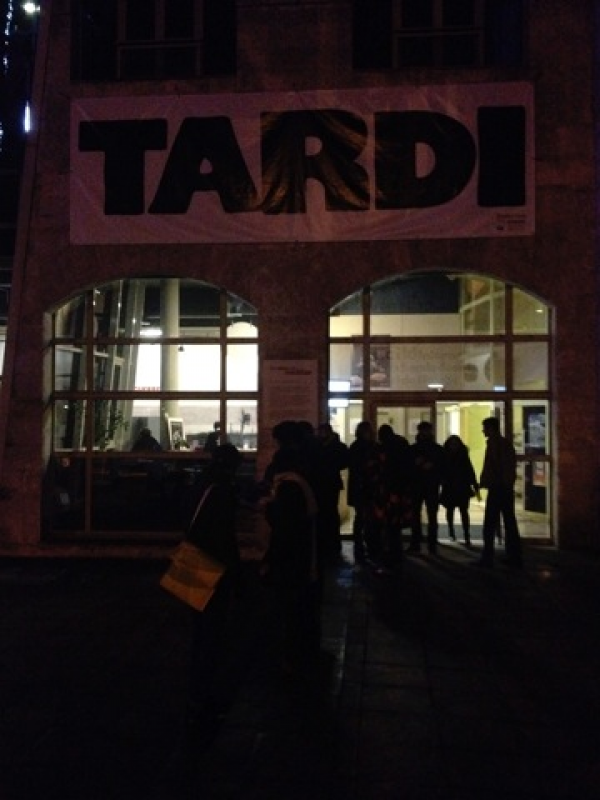
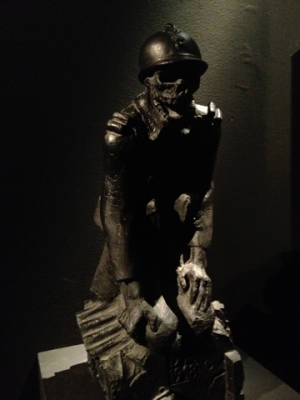
The exhibition of work by Jacques Tardi in Angouleme this year is claustrophobic, poorly lit, and monotonous.
These very qualities make this a landmark exhibition, undoubtedly one of the best comics shows I have ever seen.
And believe me, I've seen plenty. In a minor fashion, I was involved in the Masters of American Comics exhibition that started at the Hammer Museum in Los Angeles, and so I have some insider's knowledge of how difficult it is to install a show of comic art.
Comics are meant for in-the-hand reading. The cartoonist works with that precept and the publisher obliges by making objects that you have to hold to read. The advent of electronic reading devices has made comics consumption an even more intimate experience.
This makes hanging comics on a wall a tricky proposition -- because you immediately objectify the original pages, whose design and function have been built on subjective manhandling.
The Tardi exhibition operates with a full understanding of this problem -- and uses that awareness to create a situation that forces the reader to embrace his powerful work in an intimate way.
Though the iconoclastic Tardi may not like to hear this, Tardi is an icon, an elder statesman of French comics who has worked successfully in many genres. But his most personal and forceful work are the hundreds of pages that he has spent chronologically chronicling the First World War in France.
The work is intense, brutal, gory, and unrelenting in its aim: to grab the reader by the lapels and lift him off the ground, shaking him out of the complacency that set in early after the Great War to matter-of-factly accept the unacceptable murder of thousands and the seismic ripple those deaths made through the generations.
And because of this, the Tardi exhibit is not a display of work but a continuation of one man's artistic mission.
At first the exhibit-goer may be put off by the space, which is claustrophobic. The walls are constructed of rough-hewn pine boards. The work is hung like lined-up dog tags. The lights emit a subdued incandescent glow, not dim, but not particularly illuminating. As you wander from space to space you may not be certain if you have already been in this gallery before. The soundtrack for the entire experience combines the sounds of a woman (Dominique Grange, Tardi's wife) singing songs of the era with a constant distant rumble of artillery.
Welcome to the trenches.
The work on the walls can be read as narrative sequences. In fact, each gallery space represents a different year of the war. But the experience can also be absorbed by tuning in and out of individual pieces: a body suspended in barbed wire, a child holding a pistol, smoke across the distant no-man's land. Either way, it's chilling.
2014 is the 100th anniversary of the start of the War, and Tardi will not let you forget it.
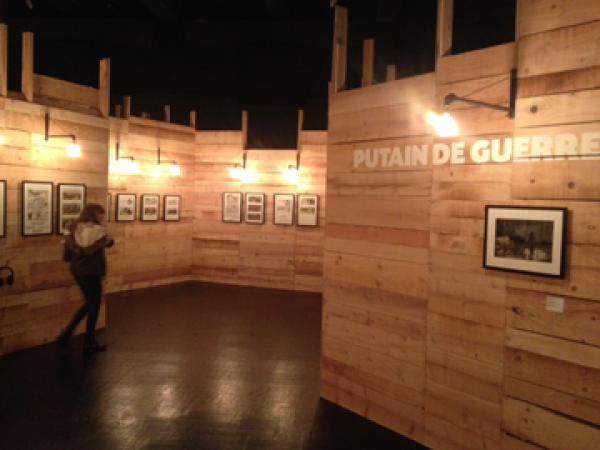
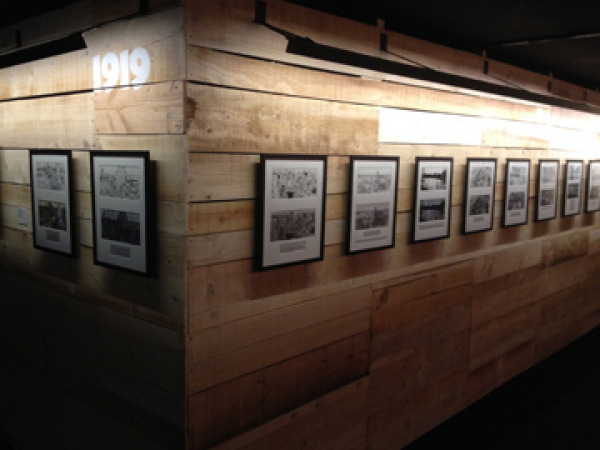
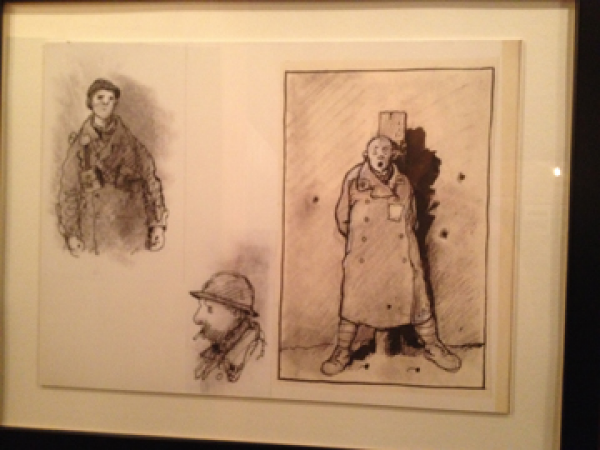
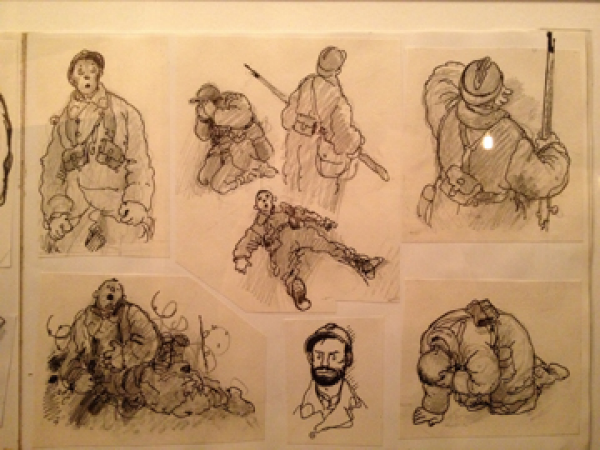
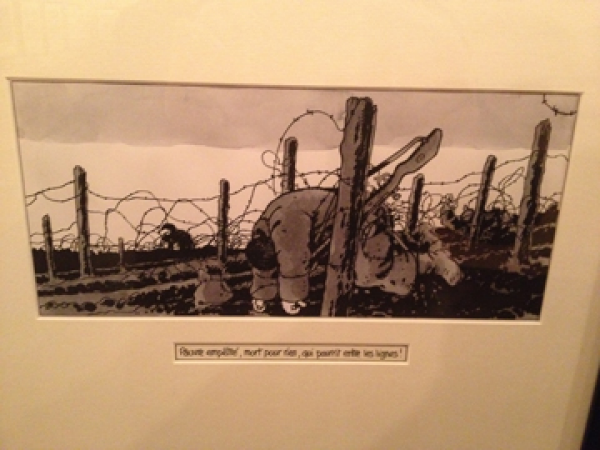

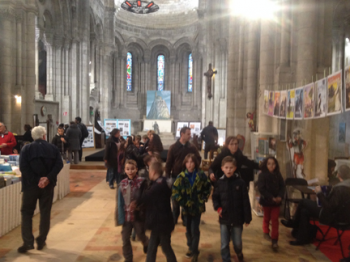
If you are now on your second day of the Angouleme Festival, you may be ready to get away from anything resembling comics and comics fans. How about ducking into a church?
In the grand tradition of most small cities in Europe, Angouleme has a lot of churches. Wasn't there a Donald Barthelme story about a town that was nothing but churches? Angouleme comes close, edged out only by the ratio per capita of bakeries. On the 12-minute walk from my hotel to my local Angouleme supermarket, there are six bakeries. Believe me, I know.
So during the Festival, if you are looking for some mid-day solitude from the rumble of the foot traffic, why not stop into one of these churches to take time off from comics and silently contemplate your deep moral personal questions (such as, exactly how are you going to explain the credit card charges for comics to the wife once you get back to the States)?
Uh-oh... you are merde-out-of-luck! Even the churches are filled with comics exhibits and fans!
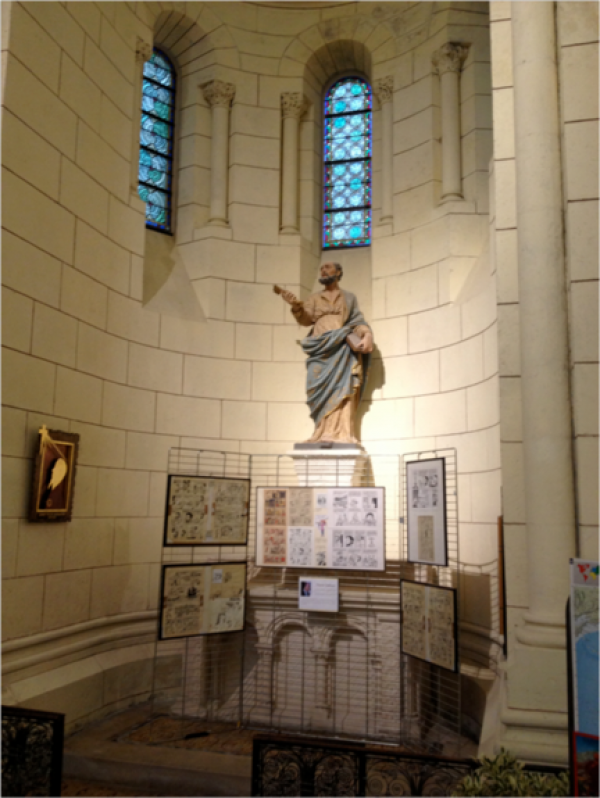
Hmmm... maybe the prestigious Angouleme Museum might be worth a quiet side-trip to avoid the crowds?
Uh-oh... they are running an exhibit on the first floor of COMICS! Unless you are fans of something called Ernest & Rebecca, a comic for the kiddies that appears to feature a petulant brat with purple hair ("Rebecca") and a cute green something with big eyes ("Ernest"), dash past the throngs of Ernest & Rebecca fans and climb upstairs.
Never mind. I'll let you in on a secret. During the Festival the Angouleme Museum is one of the best places to get away from comics throngs... once you go upstairs. Chances are you'll have the place to yourself.
"But, Paul," you protest, "I came to Angouleme 'cause I'm a comics fan! I don't go for that high-brow museum art! I like my art to be filled with sex, violence, scatology, and weird stupid stuff!"
Mathilde, one of my students from the EESI school, grew up in Angouleme and was an Angouleme Museum guard. She cued me into a couple of secrets to delight the typical crass comics fan. I now share these secrets with you!
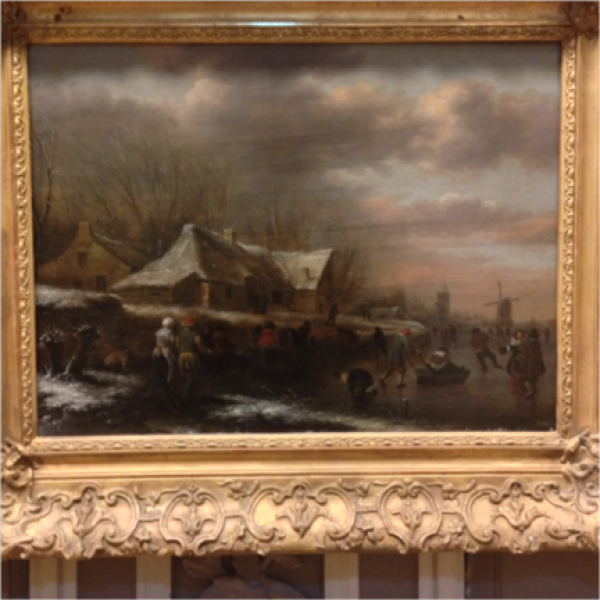
Seems like a typical rustic genre scene, yes? ["Scene d'auberge," by David Teniers, 1610-1690].
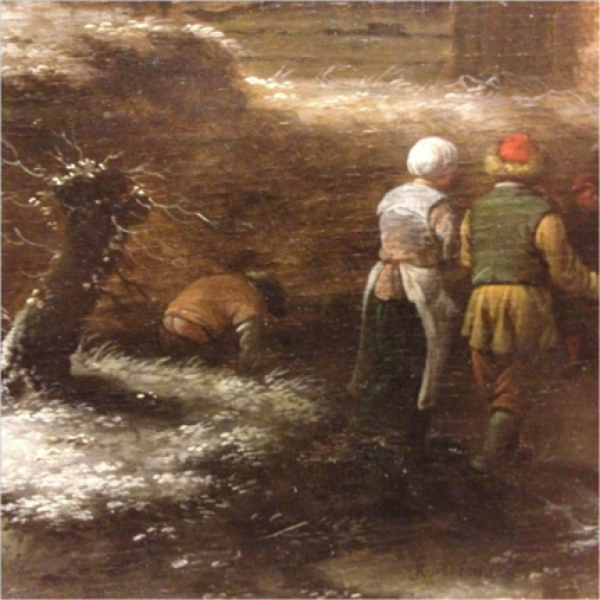
Look closer! It's rustic, alrighty! There's a guy, painted about an inch tall, dropping his Flemish drawers next to the skating rink.
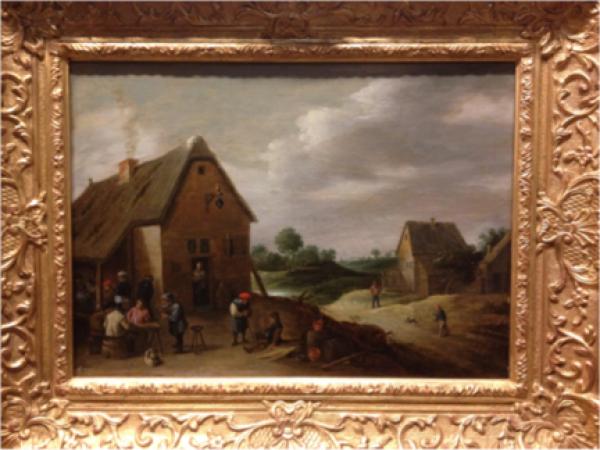
This next one I discovered all by myself ["Scene de Patinage," by Claes Molenaer, 1660]:
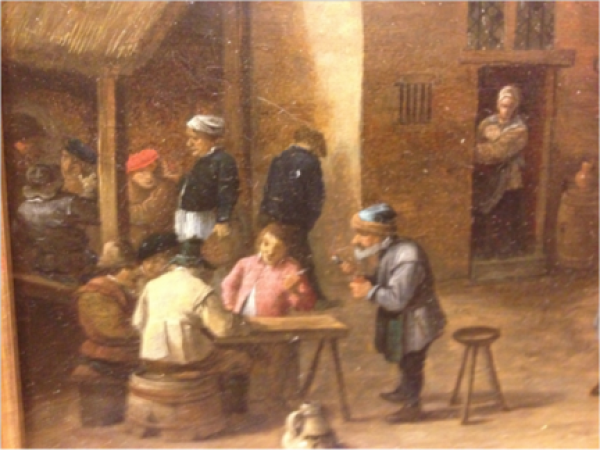
Different artists, but the same rascal picture-bombed into both paintings! This time he is taking a leak.
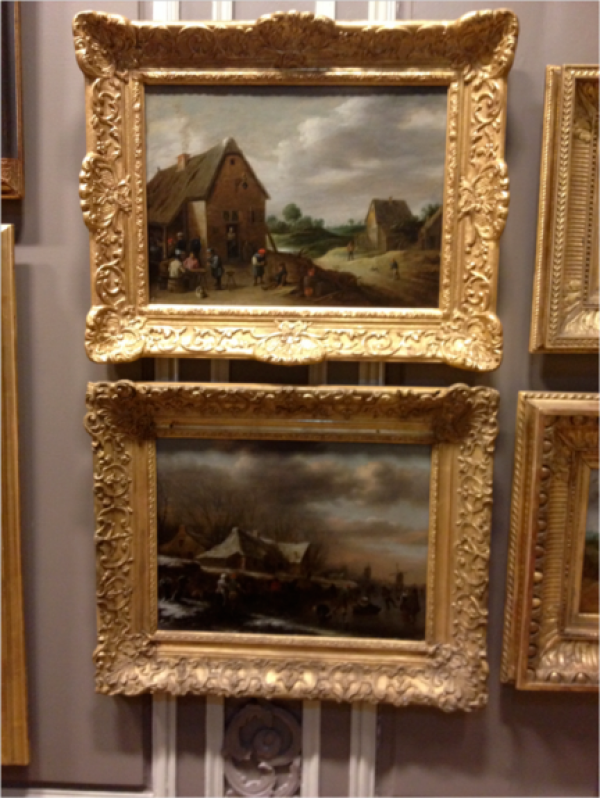
This is how they are displayed on the wall. Don't tell me that the Angouleme Museum curator does not have a jolly sense of humor!
O.K.... so much for the scatology category. Now for the sex and violence. The Magred collection was assembled by Dr. Jules Lhomme, a resident of Angouleme who never set foot in Africa yet amassed one of the finest collection of 19th century African artifacts in any museum. Just how he assembled this collection during the so-called Colonial Period, I leave up to your 21st century imagination.
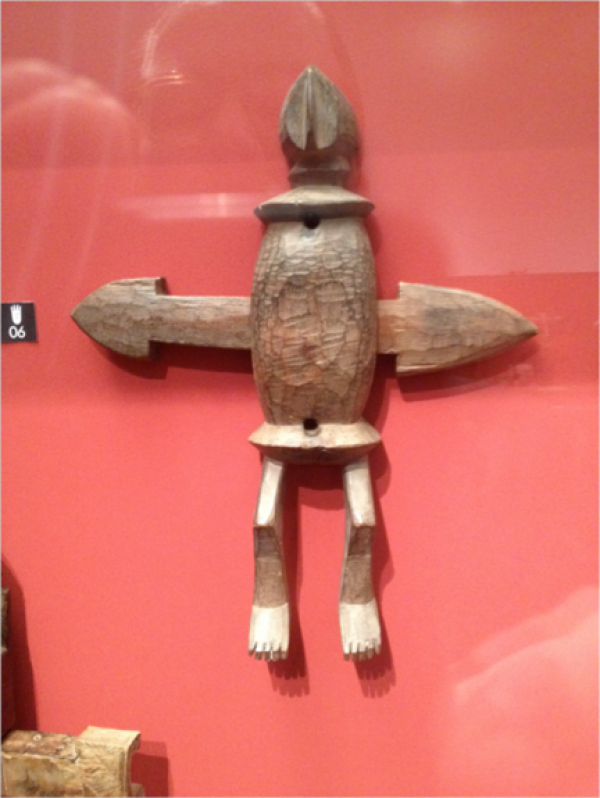
You want violence?
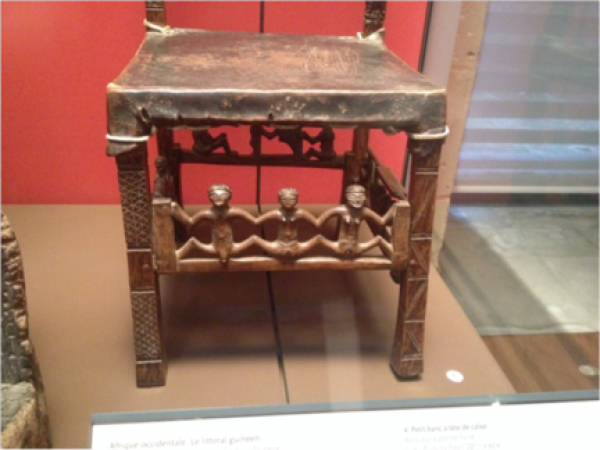
You want sex?
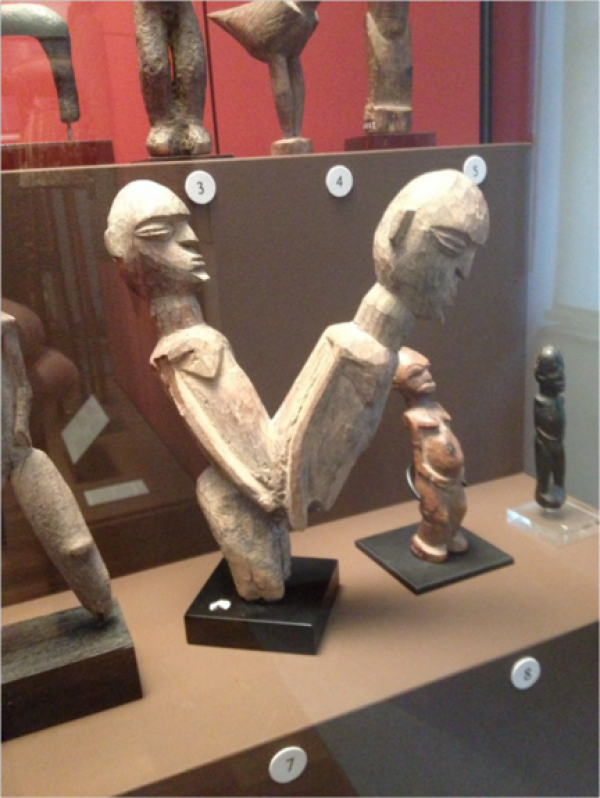
You want explicit sex?
I have been to this museum on numerous occasions but never noticed this odd composition until Mathilde pointed it out to me.
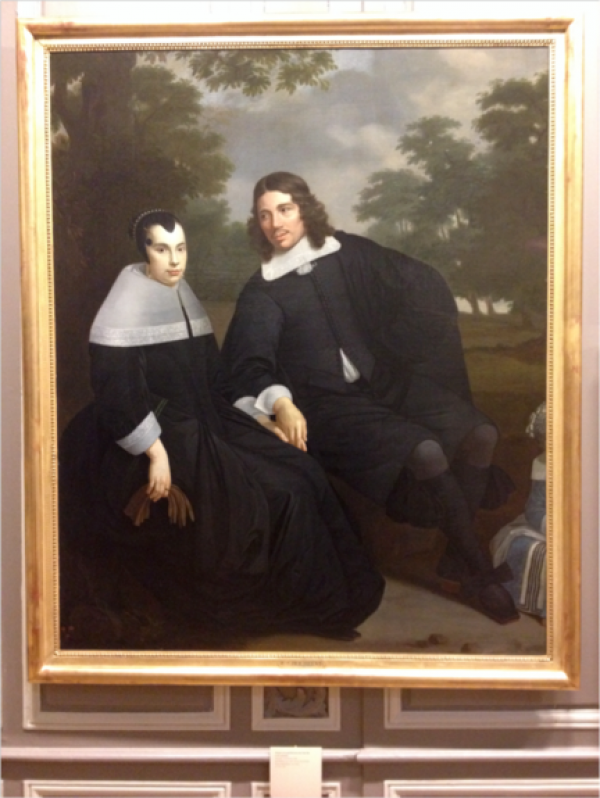
Back in the day, before Photoshop, if you wanted to delete someone from the family portrait, you just used a scissors and bought a smaller frame!
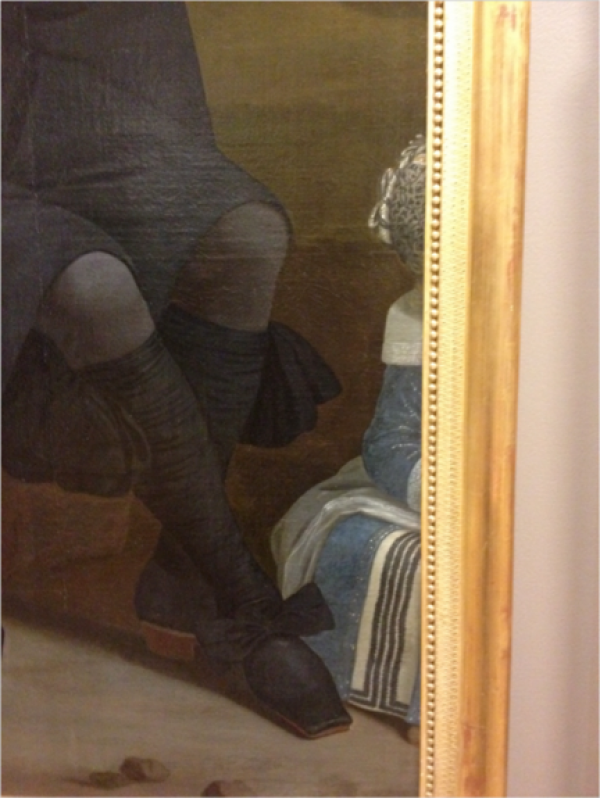
Now a close-up of the above by Barthelemy Van Der Helst, 1655. It is titled, "Portrait of a gentleman from Pays-Bas and his Wife," but a more accurate title might be, "Portrait of a gentleman from Pays-Bas and his Wife and their Ungrateful Daughter Who Grew Up and Ran Off with the Baker's Son."
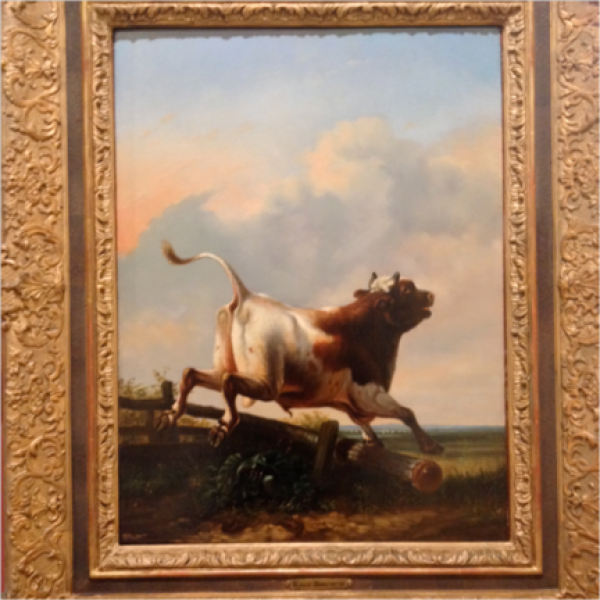
Finally, everyone whom I speak to in Angouleme about the museum mentions this mysteriously charming painting... so it would be a severe oversight to overlook "Jeune Taureau" ("Young Bull") by Rosa Bonheur (1822-1899). Why is the bull jumping over the fence and why does it bear that delightful smile and why was it ever painted in the first place? Some mysteries are better left for the ages.
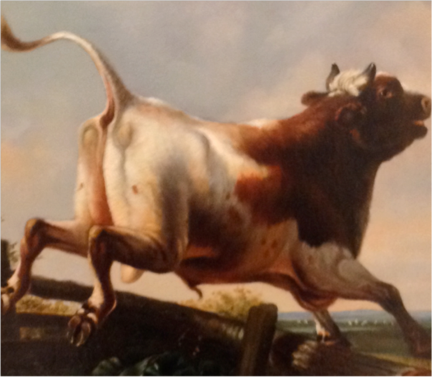

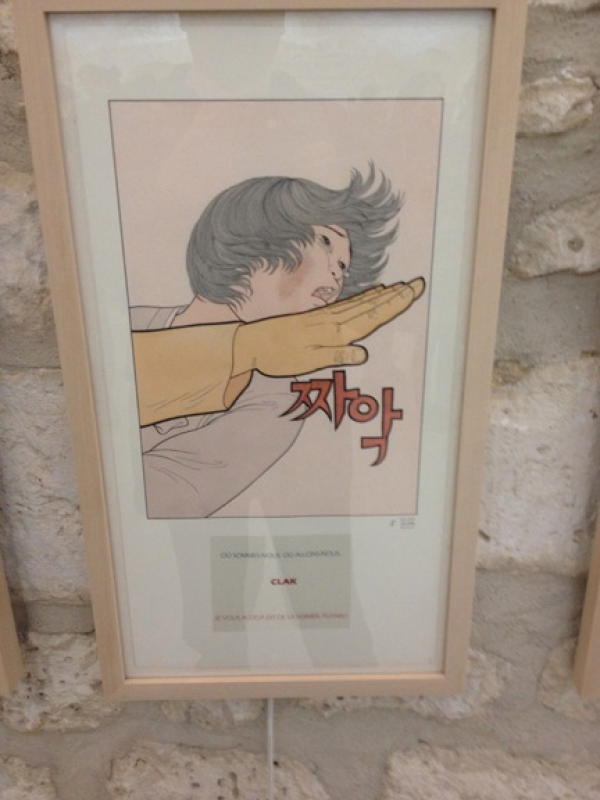
Sexual Politics
In a corner of the otherwise bustling Little Asia Pavilion at the Angouleme Comics Festival sits an empty table, prime commercial real estate sitting empty.
Across town at the Theater is a show presented by the Korean government. Visitors crowd the entrance.
What connects these two locations at the otherwise jubilant festival? Sexual slavery.
I may have some of the details wrong on this situation, lots of language barriers here, but after speaking to several people about it, I think that I have a pretty good idea of what has occurred and why that table in Little Asia is empty.
There is no disputing the fact that young Korean women were abducted by Japanese and brought to Japan to be employed as sexual slaves, or "Comfort Women." Estimates vary as to how many women were abused in this fashion.
The Korean exhibit at the Angouleme Theater opens with a fairly explicit animation of the story of one girl, who represents untold numbers of girls, and it is a terrible narrative of exportation and exploitation. It is chilling.
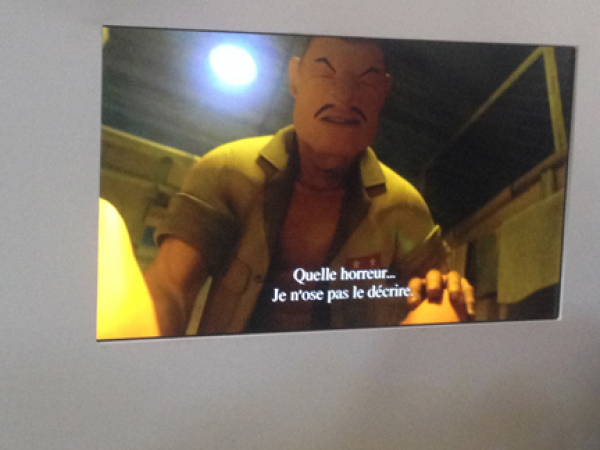
(NOTE: Those are the girl's knees in the foreground)
As you move inside to the exhibition, you see work from a dozen or so Korean cartoonists on this subject. Some are heartbreakingly beautiful, some purely symbolic, some heavy-handed and trite. All are designed to reinforce the horror.
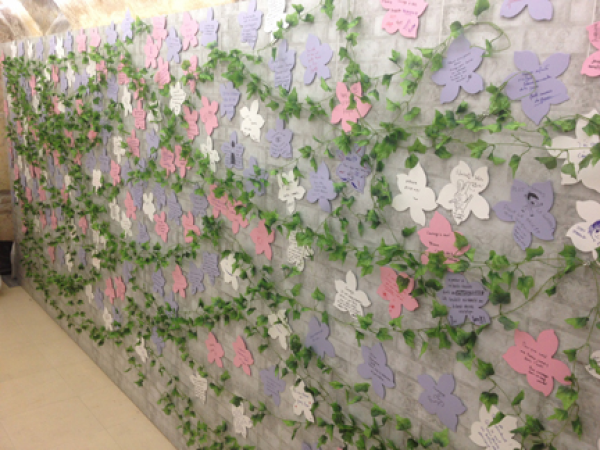
In the rear of the exhibit is a wall where visitors are invited to write notes of sympathy and indignation on pastel paper flowers to tack on the wall.
The entire effect is didactic and discomforting. The Korean government shelled out a lot of euros to construct this testament.
Meanwhile, an empty table sits seven minutes across town.
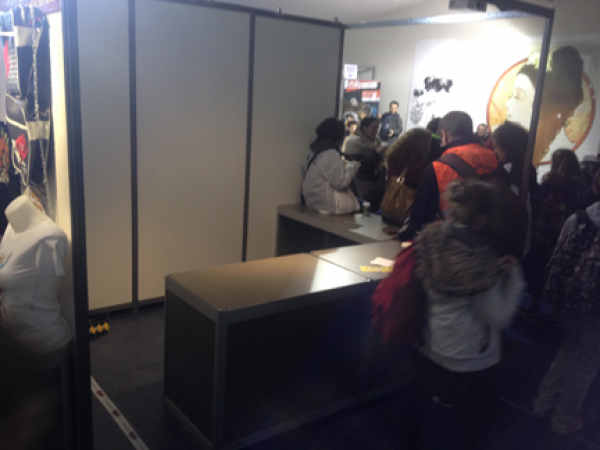
This table was going to display Japanese manga depicting versions of the story from artists from that country. The Festival shut down the booth. The table is empty.
When I asked the organizers of the Korean booth why they believe the Festival closed down the Japanese booth they said that they understood that the material in the Japanese display was created by a right wing extremist group that denies the history.
The Koreans maintained that their booth is historical information and the Japanese booth had a political agenda. They explained, patiently, that it was as if the Americans had a booth describing Pearl Harbor and the Japanese had a booth denying that the bombing ever happened.
Over the past few days the controversy has escalated. A press release was issued to the Angouleme press corps from the Japanese Ministry of Foreign Affairs that stated: "Throughout history, women's dignity and basic human rights have often been infringed upon during the many wars and conflicts of the past. The Government of Japan places paramount importance on and is committed to doing its utmost to ensure that the 21st century is free from further violations of women's dignity and basic human rights."
The press release goes to great lengths to explain its government's official position. It is not a denial and outlines the official reparations that have been made.
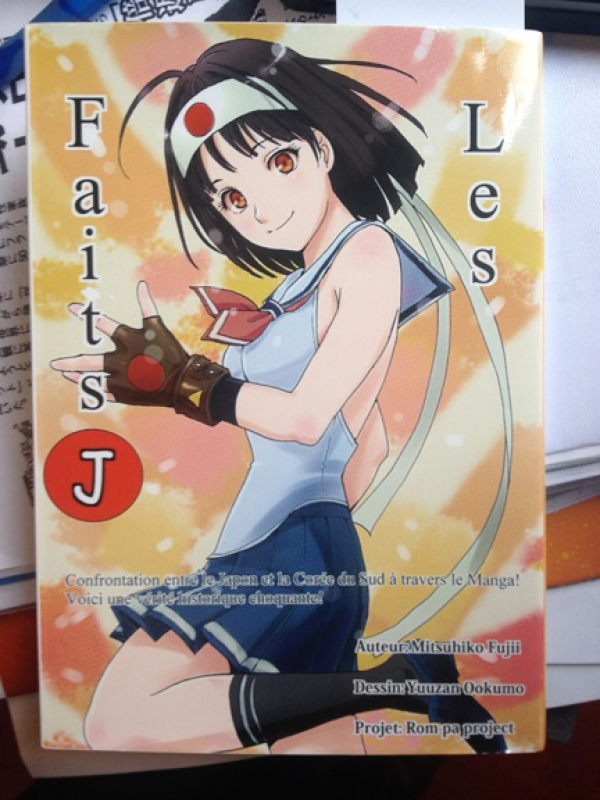
I briefly held the Japanese manga and it appeared fairly tame, but I do not read Japanese. All I could discern from a quick skim were graphs and charts amid some kind of narrative. But I did get a chance to speak to the author of the comic and his associates who are as incensed at the behavior of the Festival as they are of the Korean's version of history.
The Japanese whom I spoke with believe that the festival organizers misunderstood the wording on a banner they hung, interpreting it as a claim that there were no comfort women.
They do not dispute the existence of Comfort Girls, but they claim -- and this appears to be the linchpin -- that these girls were recruited and well-paid prostitutes, not abducted. In their eyes, they are not trying to rewrite history but trying to get their version of history, based on their research, out in the open.
Each side accuses the other of being political. Both sides believe that politics have no place at a comics festival.
Politics aside, these are ancient open wounds. The issue is still alive.
... and women are still being used as commodities in the 21st century.
I have had a swell time during this Festival, made new friends, checked in with old pals. I have seen terrific exhibitions, eaten great food, and even gotten a lot of exercise in the process of walking around town. But for me, Angouleme 2014 has been heavy.
As beautiful as they are, the exhibitions of two essential European cartoonists, Jacques Tardi and Gus Bofa, are reminders to never forget the trench warfare of World War I. The Korean-Japanese dispute is a reminder to never forget the hell of World War II. Both underline the inhumanity capacity of humans.
See you in the funny pages.
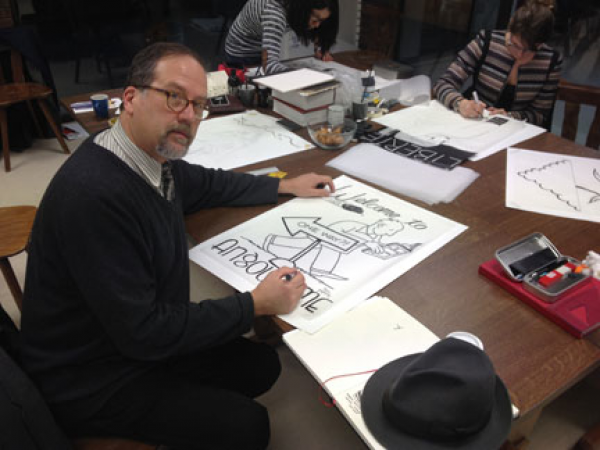
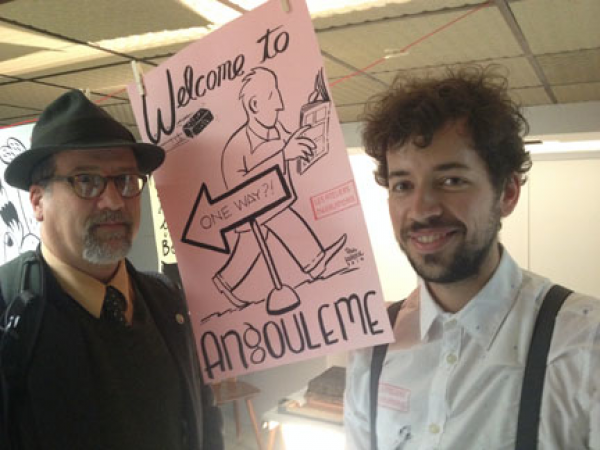
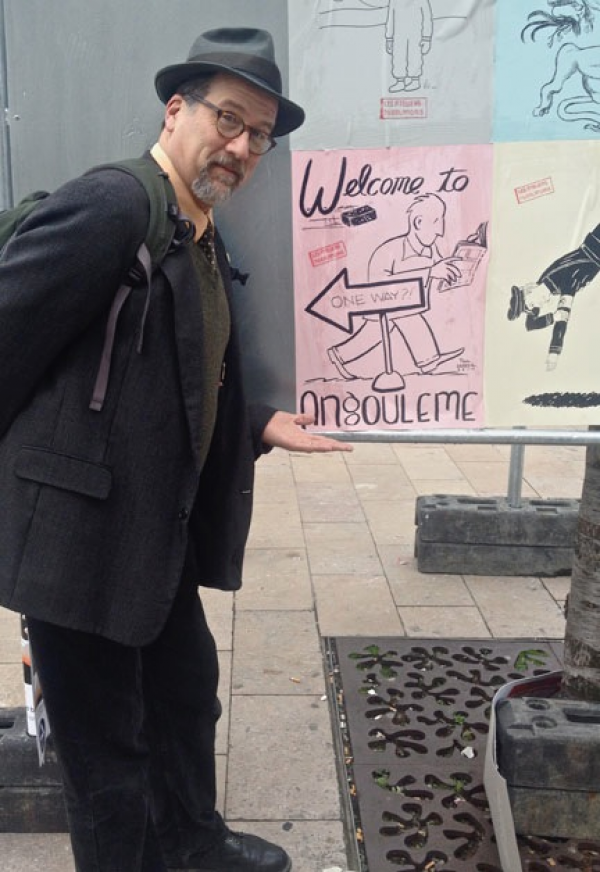
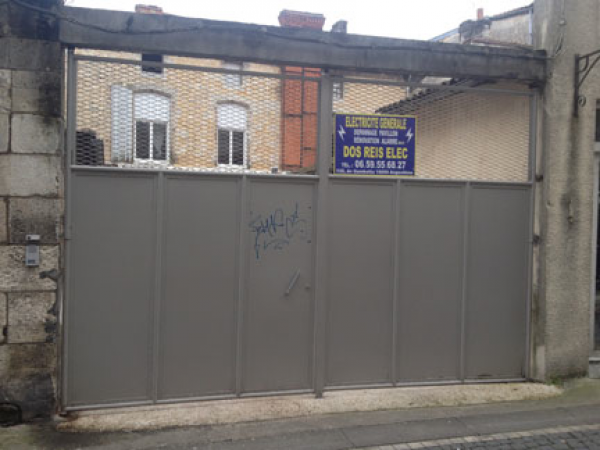
I attended my first Angouleme Festival seven or eight years ago. That year, an alternative comics store popped-up on a side street. Adjacent to the store, the purveyors had painted a reproduction of one of Richard McGuire's "Popeye" designs on a metal gate. Over the years the mural has been vandalized and finally, inevitably, this year it received a fresh coat of gray paint.
When I first saw this sign years ago, my jaw dropped. Richard's Popeye designs are brilliant yet relatively unknown in the U.S. and here they were memorialized. Only in Angouleme! Unfortunately, I did not bring my camera that day.
So I retuned the next day in the snow, camera in hand. As I neared the door, I could see that someone else had the same idea and was taking a snapshot. It turned out to be Charles Burns.
Only in Angouleme!
*THE UGLY*
1. Let's skip the ugly.
My short list in the "Ugly" category is far too subjective. It would include such tedious subjects as the constant drizzle and four hours of sleep and the lack of a decent cup of coffee.
Instead, let's sabotage this category and rename it "The Beautiful" and end with some images by the great Gus Bofa (1883-1968).
*THE BEAUTIFUL*
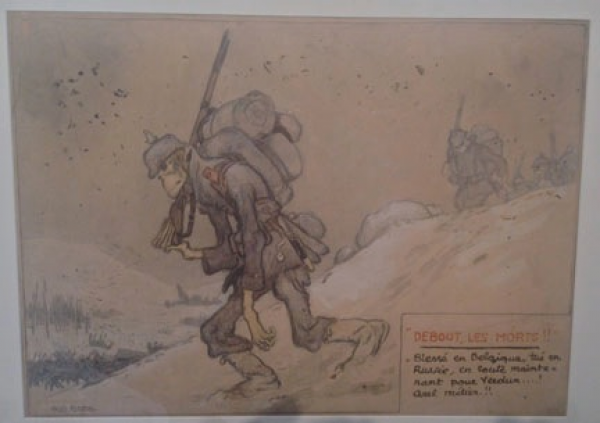
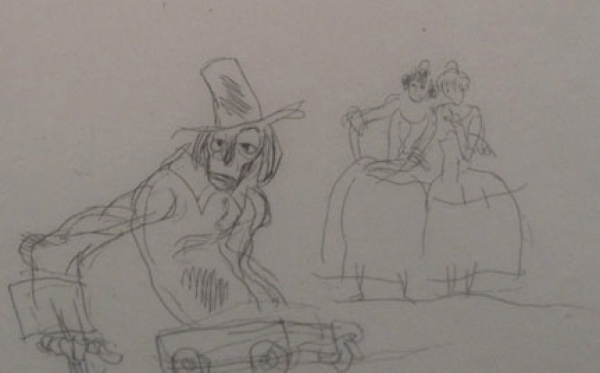
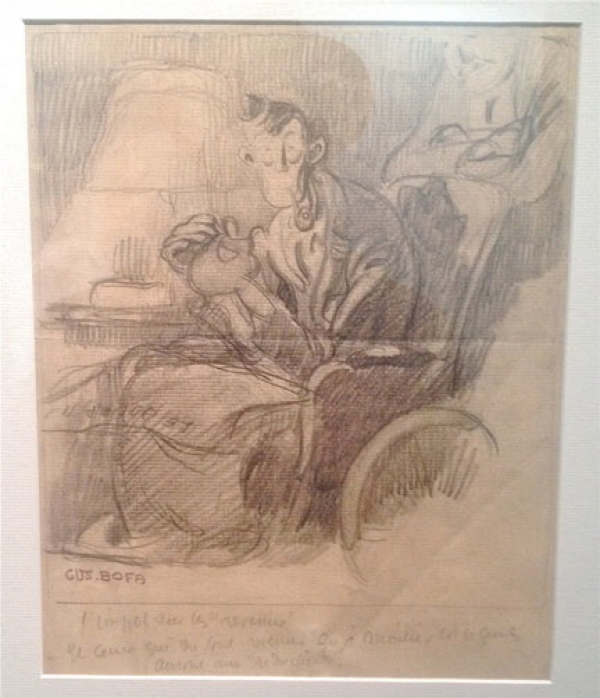
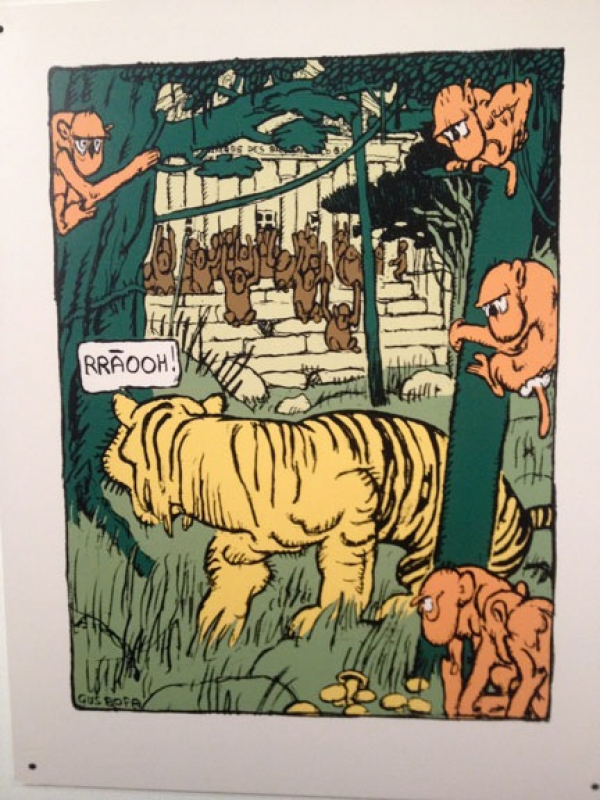
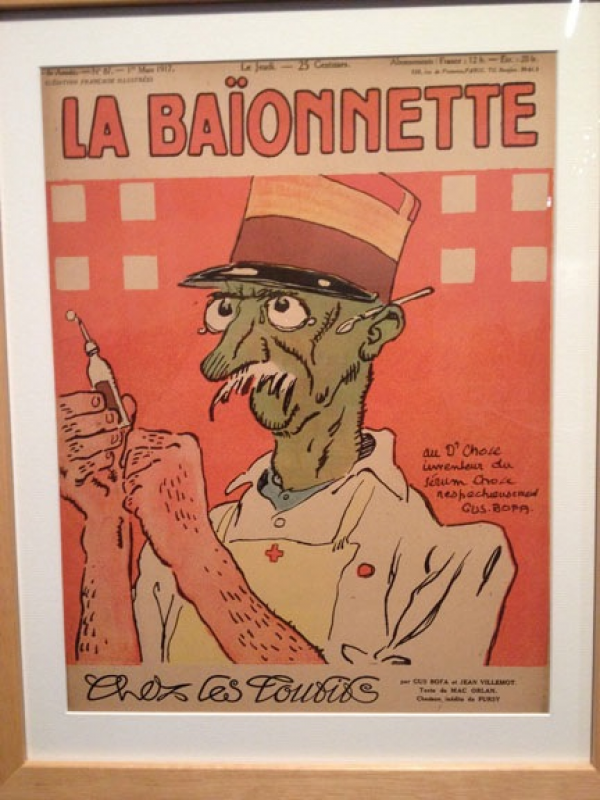
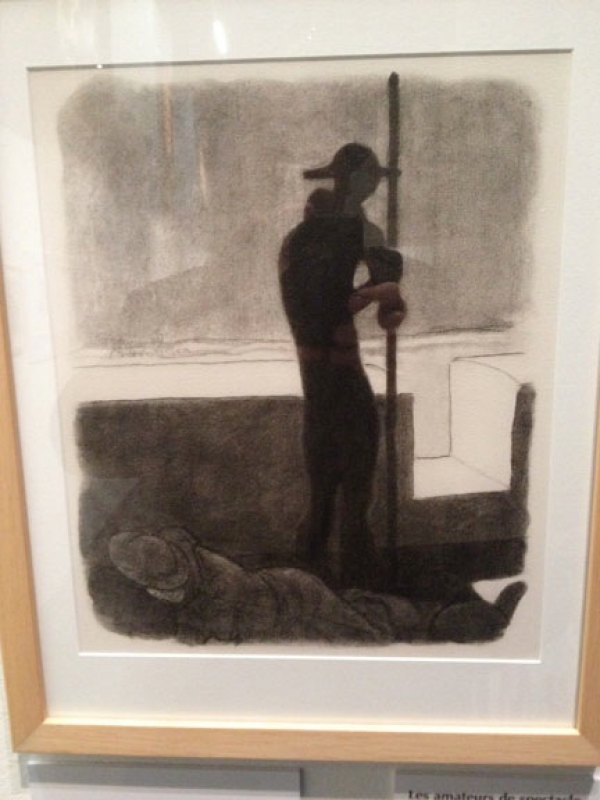
The first World War was covered by the great show by Jacques Tardi, which I have already written about. But I also wanted to let readers know about Gus Bofa's show on the same topic. Virtually unknown in the U.S., Bofa was a master illustrator best known for his on-the-spot and spot-on drawings of soldiers returned from the Great War often appearing in La Baïonnette, a French satire magazine that ran from 1915 to 1920 .
Many of the non-War drawings in the show display a sly, wistful humor. His masterful satiric drawings of daily life resonate deeply for the French. One prominent comics publisher I met admitted leaving the exhibit with a tear in his eye.
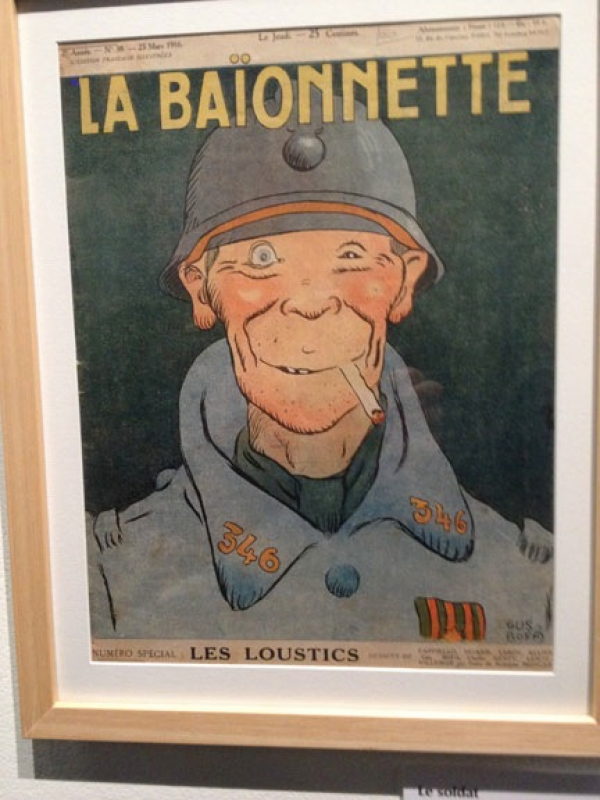
***
2. Camus + Munoz? Can someone please publish this book in English?!?!?
-->
In 2014 I wrote a series of reports for The Comics Reporter that I never got around to ganging up and presenting here. So below are all those reports in one report:
***
REPORT 1
Compared to Bart Beaty I am an Angouleme neophyte. For the past four years I have come to Angouleme for the week prior to the Festival to teach a Comics Workshop at the EESIschool (in four classes, my students create eight-page mini-comics which they proceed to sell at the Festival). After teaching, I usually stick around for the Festival.
Bart's interest and knowledge of global comics and local Angouleme festival politics far exceeds my own. I suspect that my posts will be far more anecdotal and lacking in objectivity (as well as anything resembling real news).
To those of you who have come to depend on Bart Beaty's reporting, I join you in hoping that he returns to the Festival the near future.
In the meantime:
Here are a few things you should know if you are visiting the festival for the first time.
1. It's a comics festival.
This may come as a surprise to U.S. visitors who expect Comics Festivals to be about movies and television and computer games. The focus here is comics.
Wait, let me rephrase that, the real focus here is to separate attendees from the contents of their wallets -- through comics. Comics for every taste and demographic, many of which you will find nowhere else, are for sale everywhere.
2. Angouleme is a tangled mass of tiny streets.
You will get lost as soon as you land. The festival hands out oodles of free maps that you will see overflowing from trashcans throughout the city because they are essentially useless. Even Google Maps has given up on Angouleme, replacing the usual street map on your iPhone with a color drawing of Professor Calculus holding his divining pendulum and shrugging his shoulders.
3. Skip the schedule as well as the map.
Here's an example: last year I followed the schedule and went to the location where I thought I was going to see an inking demonstration by an interesting Chinese artist. Instead I found there a living-tableau recreation of Asterix and Obelix outfoxing some Romans. I snuck out and, while trying to get my bearings, found myself in an auditorium where Joost Swarte was singing the blues -- a performance which was nowhere to be found listed on any schedule.
4. To sum it up: go with the flow.
The best way to enjoy Angouleme is to exit the train from Paris waving a white flag on a stick. Wander, be surprised, and be prepared to empty the contents of your wallet on the byways of this crazy little town.
***
REPORT 2
Jacques Tardi and The Goddamn War


The exhibition of work by Jacques Tardi in Angouleme this year is claustrophobic, poorly lit, and monotonous.
These very qualities make this a landmark exhibition, undoubtedly one of the best comics shows I have ever seen.
And believe me, I've seen plenty. In a minor fashion, I was involved in the Masters of American Comics exhibition that started at the Hammer Museum in Los Angeles, and so I have some insider's knowledge of how difficult it is to install a show of comic art.
Comics are meant for in-the-hand reading. The cartoonist works with that precept and the publisher obliges by making objects that you have to hold to read. The advent of electronic reading devices has made comics consumption an even more intimate experience.
This makes hanging comics on a wall a tricky proposition -- because you immediately objectify the original pages, whose design and function have been built on subjective manhandling.
The Tardi exhibition operates with a full understanding of this problem -- and uses that awareness to create a situation that forces the reader to embrace his powerful work in an intimate way.
Though the iconoclastic Tardi may not like to hear this, Tardi is an icon, an elder statesman of French comics who has worked successfully in many genres. But his most personal and forceful work are the hundreds of pages that he has spent chronologically chronicling the First World War in France.
The work is intense, brutal, gory, and unrelenting in its aim: to grab the reader by the lapels and lift him off the ground, shaking him out of the complacency that set in early after the Great War to matter-of-factly accept the unacceptable murder of thousands and the seismic ripple those deaths made through the generations.
And because of this, the Tardi exhibit is not a display of work but a continuation of one man's artistic mission.
At first the exhibit-goer may be put off by the space, which is claustrophobic. The walls are constructed of rough-hewn pine boards. The work is hung like lined-up dog tags. The lights emit a subdued incandescent glow, not dim, but not particularly illuminating. As you wander from space to space you may not be certain if you have already been in this gallery before. The soundtrack for the entire experience combines the sounds of a woman (Dominique Grange, Tardi's wife) singing songs of the era with a constant distant rumble of artillery.
Welcome to the trenches.
The work on the walls can be read as narrative sequences. In fact, each gallery space represents a different year of the war. But the experience can also be absorbed by tuning in and out of individual pieces: a body suspended in barbed wire, a child holding a pistol, smoke across the distant no-man's land. Either way, it's chilling.
2014 is the 100th anniversary of the start of the War, and Tardi will not let you forget it.





***
REPORT 3
Angouleme Sans Comics

If you are now on your second day of the Angouleme Festival, you may be ready to get away from anything resembling comics and comics fans. How about ducking into a church?
In the grand tradition of most small cities in Europe, Angouleme has a lot of churches. Wasn't there a Donald Barthelme story about a town that was nothing but churches? Angouleme comes close, edged out only by the ratio per capita of bakeries. On the 12-minute walk from my hotel to my local Angouleme supermarket, there are six bakeries. Believe me, I know.
So during the Festival, if you are looking for some mid-day solitude from the rumble of the foot traffic, why not stop into one of these churches to take time off from comics and silently contemplate your deep moral personal questions (such as, exactly how are you going to explain the credit card charges for comics to the wife once you get back to the States)?
Uh-oh... you are merde-out-of-luck! Even the churches are filled with comics exhibits and fans!

Hmmm... maybe the prestigious Angouleme Museum might be worth a quiet side-trip to avoid the crowds?
Uh-oh... they are running an exhibit on the first floor of COMICS! Unless you are fans of something called Ernest & Rebecca, a comic for the kiddies that appears to feature a petulant brat with purple hair ("Rebecca") and a cute green something with big eyes ("Ernest"), dash past the throngs of Ernest & Rebecca fans and climb upstairs.
Never mind. I'll let you in on a secret. During the Festival the Angouleme Museum is one of the best places to get away from comics throngs... once you go upstairs. Chances are you'll have the place to yourself.
"But, Paul," you protest, "I came to Angouleme 'cause I'm a comics fan! I don't go for that high-brow museum art! I like my art to be filled with sex, violence, scatology, and weird stupid stuff!"
Mathilde, one of my students from the EESI school, grew up in Angouleme and was an Angouleme Museum guard. She cued me into a couple of secrets to delight the typical crass comics fan. I now share these secrets with you!

Seems like a typical rustic genre scene, yes? ["Scene d'auberge," by David Teniers, 1610-1690].

Look closer! It's rustic, alrighty! There's a guy, painted about an inch tall, dropping his Flemish drawers next to the skating rink.

This next one I discovered all by myself ["Scene de Patinage," by Claes Molenaer, 1660]:

Different artists, but the same rascal picture-bombed into both paintings! This time he is taking a leak.

This is how they are displayed on the wall. Don't tell me that the Angouleme Museum curator does not have a jolly sense of humor!
O.K.... so much for the scatology category. Now for the sex and violence. The Magred collection was assembled by Dr. Jules Lhomme, a resident of Angouleme who never set foot in Africa yet amassed one of the finest collection of 19th century African artifacts in any museum. Just how he assembled this collection during the so-called Colonial Period, I leave up to your 21st century imagination.

You want violence?

You want sex?

You want explicit sex?
I have been to this museum on numerous occasions but never noticed this odd composition until Mathilde pointed it out to me.

Back in the day, before Photoshop, if you wanted to delete someone from the family portrait, you just used a scissors and bought a smaller frame!

Now a close-up of the above by Barthelemy Van Der Helst, 1655. It is titled, "Portrait of a gentleman from Pays-Bas and his Wife," but a more accurate title might be, "Portrait of a gentleman from Pays-Bas and his Wife and their Ungrateful Daughter Who Grew Up and Ran Off with the Baker's Son."

Finally, everyone whom I speak to in Angouleme about the museum mentions this mysteriously charming painting... so it would be a severe oversight to overlook "Jeune Taureau" ("Young Bull") by Rosa Bonheur (1822-1899). Why is the bull jumping over the fence and why does it bear that delightful smile and why was it ever painted in the first place? Some mysteries are better left for the ages.

***
REPORT 4

Sexual Politics
In a corner of the otherwise bustling Little Asia Pavilion at the Angouleme Comics Festival sits an empty table, prime commercial real estate sitting empty.
Across town at the Theater is a show presented by the Korean government. Visitors crowd the entrance.
What connects these two locations at the otherwise jubilant festival? Sexual slavery.
I may have some of the details wrong on this situation, lots of language barriers here, but after speaking to several people about it, I think that I have a pretty good idea of what has occurred and why that table in Little Asia is empty.
There is no disputing the fact that young Korean women were abducted by Japanese and brought to Japan to be employed as sexual slaves, or "Comfort Women." Estimates vary as to how many women were abused in this fashion.
The Korean exhibit at the Angouleme Theater opens with a fairly explicit animation of the story of one girl, who represents untold numbers of girls, and it is a terrible narrative of exportation and exploitation. It is chilling.

(NOTE: Those are the girl's knees in the foreground)
As you move inside to the exhibition, you see work from a dozen or so Korean cartoonists on this subject. Some are heartbreakingly beautiful, some purely symbolic, some heavy-handed and trite. All are designed to reinforce the horror.

In the rear of the exhibit is a wall where visitors are invited to write notes of sympathy and indignation on pastel paper flowers to tack on the wall.
The entire effect is didactic and discomforting. The Korean government shelled out a lot of euros to construct this testament.
Meanwhile, an empty table sits seven minutes across town.

This table was going to display Japanese manga depicting versions of the story from artists from that country. The Festival shut down the booth. The table is empty.
When I asked the organizers of the Korean booth why they believe the Festival closed down the Japanese booth they said that they understood that the material in the Japanese display was created by a right wing extremist group that denies the history.
The Koreans maintained that their booth is historical information and the Japanese booth had a political agenda. They explained, patiently, that it was as if the Americans had a booth describing Pearl Harbor and the Japanese had a booth denying that the bombing ever happened.
Over the past few days the controversy has escalated. A press release was issued to the Angouleme press corps from the Japanese Ministry of Foreign Affairs that stated: "Throughout history, women's dignity and basic human rights have often been infringed upon during the many wars and conflicts of the past. The Government of Japan places paramount importance on and is committed to doing its utmost to ensure that the 21st century is free from further violations of women's dignity and basic human rights."
The press release goes to great lengths to explain its government's official position. It is not a denial and outlines the official reparations that have been made.

I briefly held the Japanese manga and it appeared fairly tame, but I do not read Japanese. All I could discern from a quick skim were graphs and charts amid some kind of narrative. But I did get a chance to speak to the author of the comic and his associates who are as incensed at the behavior of the Festival as they are of the Korean's version of history.
The Japanese whom I spoke with believe that the festival organizers misunderstood the wording on a banner they hung, interpreting it as a claim that there were no comfort women.
They do not dispute the existence of Comfort Girls, but they claim -- and this appears to be the linchpin -- that these girls were recruited and well-paid prostitutes, not abducted. In their eyes, they are not trying to rewrite history but trying to get their version of history, based on their research, out in the open.
Each side accuses the other of being political. Both sides believe that politics have no place at a comics festival.
Politics aside, these are ancient open wounds. The issue is still alive.
... and women are still being used as commodities in the 21st century.
I have had a swell time during this Festival, made new friends, checked in with old pals. I have seen terrific exhibitions, eaten great food, and even gotten a lot of exercise in the process of walking around town. But for me, Angouleme 2014 has been heavy.
As beautiful as they are, the exhibitions of two essential European cartoonists, Jacques Tardi and Gus Bofa, are reminders to never forget the trench warfare of World War I. The Korean-Japanese dispute is a reminder to never forget the hell of World War II. Both underline the inhumanity capacity of humans.
See you in the funny pages.
***
REPORT 5
The Good, The Bad, and The Ugly
*THE GOOD*
1. Joe Lambert gets a prize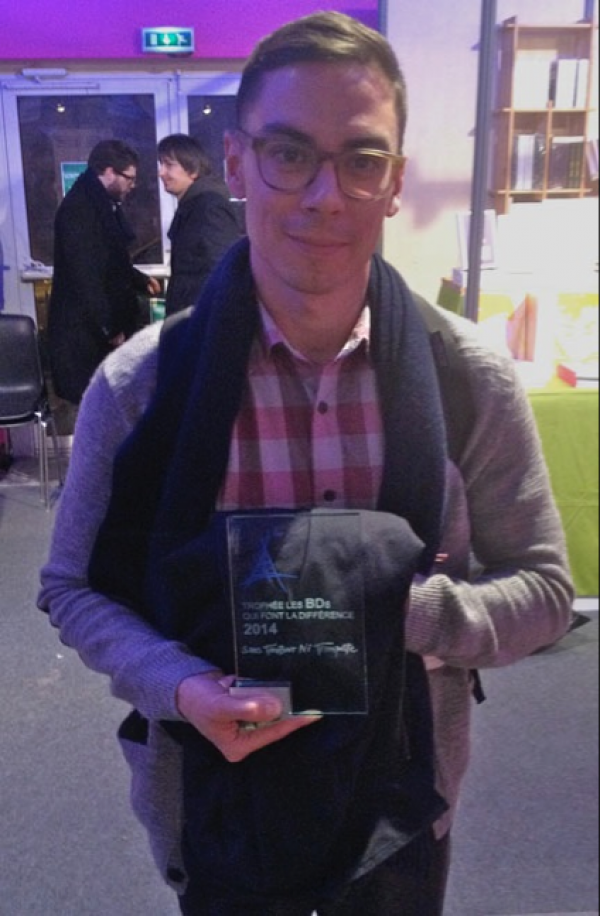
Joe Lambert's "Annie Sullivan and the Trials of Helen Keller" book is marvelously clever and moving. The book successfully navigates through treacherous cliché-infested waters and delivers the goods without sentimentality while still landing real emotion.
It's too bad that the book suffered in the U.S. from a small format that did an injustice to his detailed work.
This has been corrected in France where his publisher, Ca et La, had the good sense to reprint the translation in a large format that allows the work to shine.
Joe won an award from an organization that promotes rights for the disabled. It is a well-deserved prize.
Congratulations, Joe!
2. Netherlands Print Shop
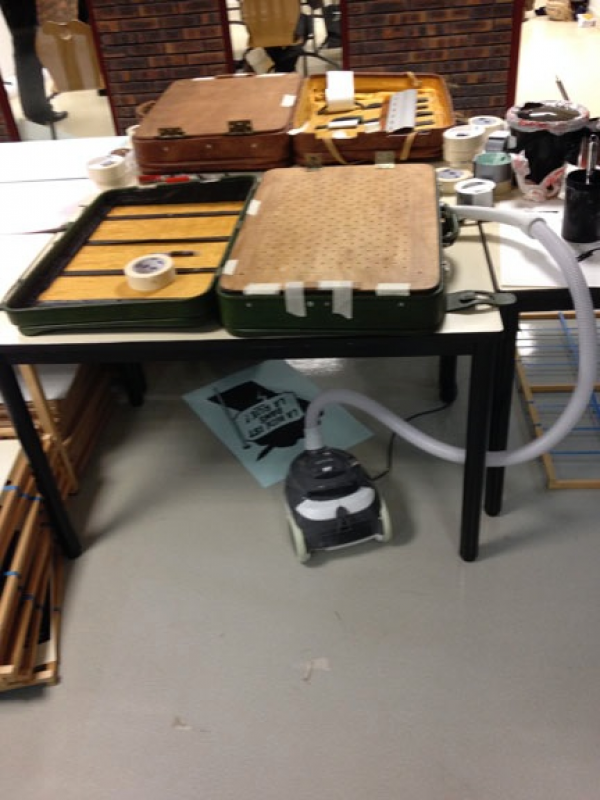
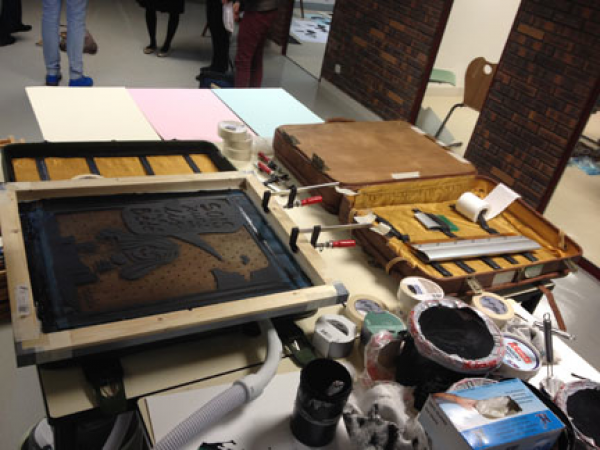
When I met up with Joost Swarte on the first day of the festival he was giddy with anticipation. The contingent from the Netherlands arrived with two suitcases and a vacuum cleaner. When the suitcases are opened and the vacuum cleaner attached, a pop-up print shop materializes.
Addjacent to the open print shop were three studios where artists set up shop, creating on-the-spot poster designs (many dealing with the day's news) on tracing paper which the printer, the young man who designed the printshop-in-a-suitcase, and his assistant pulled screen prints.
These prints were then posted all over town throughout the festival.
Visitors were invited to wander around the printshop and studios to watch the process. A playful sense of vitality kept things lively.
*THE GOOD*
1. Joe Lambert gets a prize

Joe Lambert's "Annie Sullivan and the Trials of Helen Keller" book is marvelously clever and moving. The book successfully navigates through treacherous cliché-infested waters and delivers the goods without sentimentality while still landing real emotion.
It's too bad that the book suffered in the U.S. from a small format that did an injustice to his detailed work.
This has been corrected in France where his publisher, Ca et La, had the good sense to reprint the translation in a large format that allows the work to shine.
Joe won an award from an organization that promotes rights for the disabled. It is a well-deserved prize.
Congratulations, Joe!
2. Netherlands Print Shop


When I met up with Joost Swarte on the first day of the festival he was giddy with anticipation. The contingent from the Netherlands arrived with two suitcases and a vacuum cleaner. When the suitcases are opened and the vacuum cleaner attached, a pop-up print shop materializes.
Addjacent to the open print shop were three studios where artists set up shop, creating on-the-spot poster designs (many dealing with the day's news) on tracing paper which the printer, the young man who designed the printshop-in-a-suitcase, and his assistant pulled screen prints.
These prints were then posted all over town throughout the festival.
Visitors were invited to wander around the printshop and studios to watch the process. A playful sense of vitality kept things lively.
Curious about Joost's description, I dropped by early on Wednesday to say hello and see what they were up to. I was honored to be handed a brush and a sheet of tracing paper
 |
| Here is Typex at work trying not to get ink on his nice yellow shirt. |
 |
| Quiet! Swarte at Work!!! |

 |
| Here is my drawing done of tracing paper. |


 |
| Posters as displayed around town. *** |
3. Ted Stearn's book, "Fuzz and Pluck" won a prize. 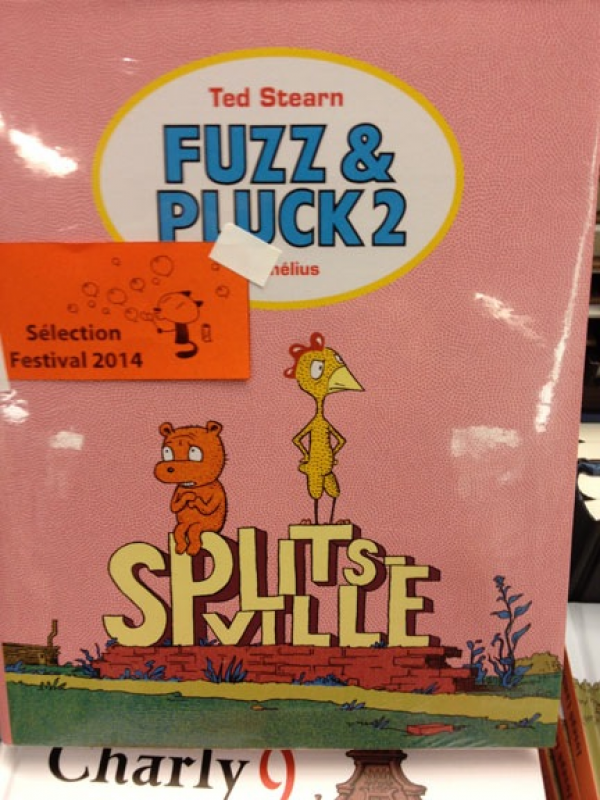
Ted is a pal of mine and I love this book. It may look like a not-so-funny animal comic, but it is so much more. Plus it is laugh-out-loud funny.
Mazel tov!
*THE BAD*
1. Japanese/Korean relations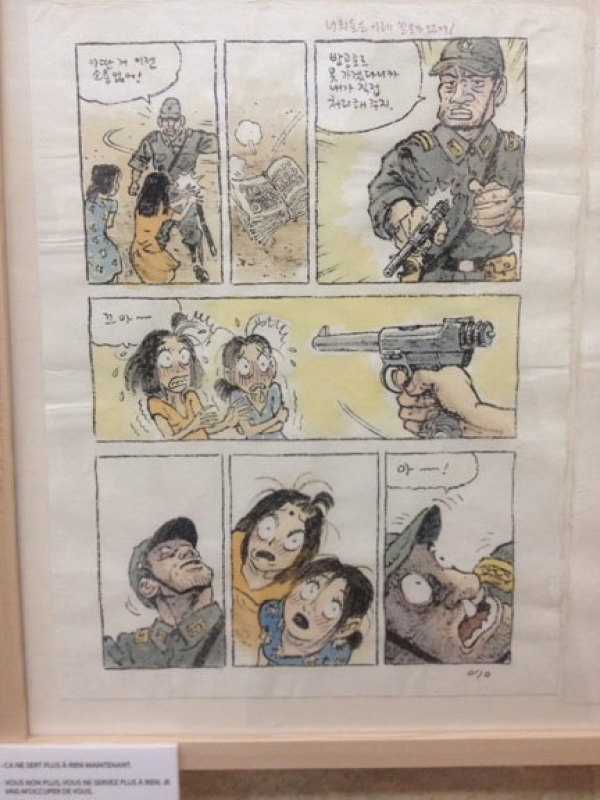
As I wrote about in a prior column, there was an ugly incident regarding a book banned from the Festival. As a rule -- and as an American? -- I am opposed to book-banning, but, after speaking to the man who actually blew the whistle, I understand how this came about.
The manga questions the WWII practice of the abduction of Korean women to use as prostitutes in Japan, asserting that the women were recruited and paid. Comics historian and writer Thierry Smolderen, pointed out that this is not really a much better scenario and actually may shed a worse light on the Japanese.
At any rate, the whistle-blower agreed with me that had the book been placed with a bunch of other manga on the Japanese table, he probably would not have noticed it and the whole controversy would not have erupted.
The Japanese contingent, however, made sure that people knew about the manga because they came to the Festival to make a point: they disagreed graphically with the Korean version of the history. They positioned themselves as nay-sayers -- but were viewed by many as extremist revisionists.
Ultimately, the event served to underline ongoing tensions between these countries... and the sad, brutal history of sexual exploitation that continues today.
2. Popeye adieu

Ted is a pal of mine and I love this book. It may look like a not-so-funny animal comic, but it is so much more. Plus it is laugh-out-loud funny.
Mazel tov!
*THE BAD*
1. Japanese/Korean relations

As I wrote about in a prior column, there was an ugly incident regarding a book banned from the Festival. As a rule -- and as an American? -- I am opposed to book-banning, but, after speaking to the man who actually blew the whistle, I understand how this came about.
The manga questions the WWII practice of the abduction of Korean women to use as prostitutes in Japan, asserting that the women were recruited and paid. Comics historian and writer Thierry Smolderen, pointed out that this is not really a much better scenario and actually may shed a worse light on the Japanese.
At any rate, the whistle-blower agreed with me that had the book been placed with a bunch of other manga on the Japanese table, he probably would not have noticed it and the whole controversy would not have erupted.
The Japanese contingent, however, made sure that people knew about the manga because they came to the Festival to make a point: they disagreed graphically with the Korean version of the history. They positioned themselves as nay-sayers -- but were viewed by many as extremist revisionists.
Ultimately, the event served to underline ongoing tensions between these countries... and the sad, brutal history of sexual exploitation that continues today.
2. Popeye adieu

Photo by Charles Burns

I attended my first Angouleme Festival seven or eight years ago. That year, an alternative comics store popped-up on a side street. Adjacent to the store, the purveyors had painted a reproduction of one of Richard McGuire's "Popeye" designs on a metal gate. Over the years the mural has been vandalized and finally, inevitably, this year it received a fresh coat of gray paint.
When I first saw this sign years ago, my jaw dropped. Richard's Popeye designs are brilliant yet relatively unknown in the U.S. and here they were memorialized. Only in Angouleme! Unfortunately, I did not bring my camera that day.
So I retuned the next day in the snow, camera in hand. As I neared the door, I could see that someone else had the same idea and was taking a snapshot. It turned out to be Charles Burns.
Only in Angouleme!
*THE UGLY*
1. Let's skip the ugly.
My short list in the "Ugly" category is far too subjective. It would include such tedious subjects as the constant drizzle and four hours of sleep and the lack of a decent cup of coffee.
Instead, let's sabotage this category and rename it "The Beautiful" and end with some images by the great Gus Bofa (1883-1968).
*THE BEAUTIFUL*






The first World War was covered by the great show by Jacques Tardi, which I have already written about. But I also wanted to let readers know about Gus Bofa's show on the same topic. Virtually unknown in the U.S., Bofa was a master illustrator best known for his on-the-spot and spot-on drawings of soldiers returned from the Great War often appearing in La Baïonnette, a French satire magazine that ran from 1915 to 1920 .
Many of the non-War drawings in the show display a sly, wistful humor. His masterful satiric drawings of daily life resonate deeply for the French. One prominent comics publisher I met admitted leaving the exhibit with a tear in his eye.

***
REPORT Addendum
1. I went to Angouleme a week prior to the festival to teach at the EESI school where they have a two year Masters program in Comics. In four day-long classes, my wonderful students made 8-page mini comics. That's writing, pencilling, lettering, inking, printing, and binding while the clock is ticking and I am drumming my fingers on the desk.
They did splendid work and then sold out their mini-comics at the Festival. We took the profits from the sales and donated them to a needy cause, 'cause we needed a party!
***  |
 |
4. Paul Karasik, Florent Ruppert, Thierry Smolderen, Dominique Bertail after an odd film showing of remixed Louise Brooks footage with live Mozart played on the piano. All agreed that any opportunity to watch Louise Brooks must be embraced...but Dominique was wistful. "Just think all those people in all those crowd shots are dead. Even Louise Brooks: dead," he sighed.
***
***
6. I guess that the single biggest thrill for me was meeting Herr Seele, part of the team responsible for "Cowboy Henk". I sat for a portrait that he did of me straight in ink as we chatted. He puts Luis Buñuel at the top of his list of influences and he loves Ernie Bushmiller. As a flourish, he added Cowboy Henk whispering sweet nothings in my ear.
***
7. Maybe the coolest exhibit was Guillaume Trouillard's illustrations. You had to climb up an endless stone spiral staircase to reach the exhibit space. I ran into a Saint Bernard with a small refeshing keg on the way to the top where a nurse with a respirator awaited.
***
8. I know that this looks like a portrait of cartoonist, Hugo Pratt's, famous Corto Maltese character...but it is really a Coke machine on the street. Don't know who Corto Maltese is? Save yourself the plane fare 'cause they will not let you into Angouleme.
***
 |
| Joe Lambert, Paul Karasik, Chuck Forsman, &; Alec Longstreth
9. Occasionally Americans are allowed into Angouleme but only if they behave themselves or smoke or know who Corto Maltese is.
|
***
10. Posters displayed on the street. No comment.













No comments:
Post a Comment